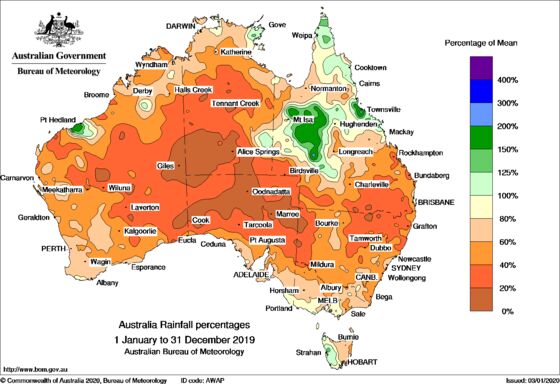Fire-Hit Australia Sees Little Relief After Hottest Year Ever
Fire-Ravaged Australia Sees Only Mild Relief After Hot, Dry Year
(Bloomberg) -- Australia’s fire-ravaged east isn’t expected to see immediate relief after the nation suffered the hottest and driest year on record.
Rainfall in the nation’s most-populous region is expected to be average or less for the coming months, while above-normal temperatures will continue to sear the world’s driest inhabited continent, the Bureau of Meteorology said Thursday in its annual climate statement. It also confirmed that 2019 was the hottest year in temperature records since 1910 and the driest in data going back to 1900.

“There is nothing really indicating that things will cool down too much over the next few months,” Karl Braganza, the bureau’s head of climate monitoring, said during a media call. “I’d optimistically say less dry rather than wet.”
Smoke from the deadly blazes, which has smothered cities including Sydney and Canberra, has spread halfway across the world to Argentina. The unfolding disaster has also intensified criticism of Prime Minister Scott Morrison’s government for downplaying the link between the huge wildfires and climate change and for not taking stronger steps to curb carbon emissions.

“We’ve got very well-defined and clear trends underlying the changes that we’ve seen over the past several decades,” Braganza said. “We’re getting more fire weather during the season and the fire weather we’re seeing is more severe. And that’s reflected in heatwaves as well over many parts of the continent.”
| Selected records from Australia’s 2019 Annual Climate Statement: |
|---|
|
Australia is suffering the brunt of global climate change, with temperatures rising faster than elsewhere. Average temperatures worldwide last year were 0.6 degree Celsius higher than the average from 1981 to 2010, according to Europe’s Copernicus Climate Change Service. In Australia that was 1.1 degrees, Bureau of Meteorology data show.
While global mean temperatures didn’t beat the annual record set in 2016, it was the hottest year without the heating effects of an El Nino climactic event.
“Normally you get a little bit of a push from El Nino to increase temperatures” globally, Braganza said. “We don’t have strong indications of what the El Nino southern oscillation is going to do into 2020 and that’s going to set a lot of what we’re looking at.”
January, which is typically Australia’s wettest month, has started off drier than normal across most of the country after both November and December saw the least rainfall on record. The delayed monsoon season in the north may start as early as next week, according to the bureau.
“We didn’t get much influence from the monsoon or any early monsoonal activity,” Braganza said. “That delayed monsoon has also been quite significant in contributing to how dry and warm it’s been, including the propensity for the fire weather.”
To contact the reporter on this story: Rob Verdonck in Sydney at rverdonck@bloomberg.net
To contact the editors responsible for this story: Ramsey Al-Rikabi at ralrikabi@bloomberg.net, Rob Verdonck
©2020 Bloomberg L.P.